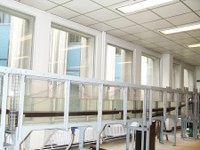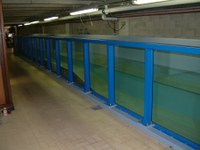Infrastructure and Services
Experimental facilities
The Coastal Engineering research group has 2 physical wave flumes, in which experimental studies are performed. The wave flumes are extensively used for research in the context of Master's theses, PhD theses and projects for government or industry.
Physical wave flumes
Small physical wave flume
This flume has been fully operational since February 1999. Its primary objective is to assist students when exploring wave dynamics, and to allow the researchers to get a better understanding of waves and wave/structure interaction using the wave flume. All components for the flume (steel construction, step motor, motor steering, software for wave generation, acquisition and analysis, ...) have been designed in-house.
The flume dimensions are 15.0 x 0.35 x 0.60 m (L x W x H). Design water depth is 0.30 m. Maximum wave height inside the flume is about 0.20 m.Large physical wave flume
The large flume has been fully operational since March 2003. The objective of the flume is to get a better understanding of waves and wave/structure interaction on a larger scale than it was possible up till now in the small wave flume of the department. The large flume is used for research purposes and project activities.
The flume measures 30.0 m long, 1.0 m wide and 1.2 m high. The overall design water depth is 80 cm. The maximum wave height in the flume is about 0.35 m.Mobile wave flume
The mobile wave flume is a transportable demonstration tool. Its main purpose is to demonstrate the type of research performed by the Coastal Engineering Research Group of UGent in a very small scale to a wide audience (e.g. companies, high schools or networking events). This ranges from the visualization of orbital motions of water particles, reflection characteristics of waves, as well as irregular and regular wave trains. Additionally wave structure interaction processes can be shown for a dike, quay wall and underwater breakwater. The active wave absorption is implemented by a filter algorithm counteracting the reflected waves.
The mobile wave flume has a length of 2.15 m, a width of 24 cm, a height of 35 cm and is equipped with a piston type wave paddle driven by a motor on one side.
Coastal and Ocean Basin
The new Coastal and Ocean Basin (COB) at Ostend Science Park is operational since 2023. The facility is part of the Gen4Wave project on renewable energy and coastal engineering in Flanders (Belgium), and is co-funded by the Hercules foundation and the Ministry of Mobility and Public Works. The exploitation will be managed by UGent, KU Leuven and Flanders Hydraulics Research. The basin will be equipped with a unique combination of a narrow paddle wavemaker in L-shape and a bidirectional current system, to achieve high quality short-crested waves at almost any relative angle with the current.
The COB is 30m long by 30m wide and has a variable water depth up to 1.4m, allowing for test conditions from coastal to near offshore applications. A pit located in the middle of the basin allows experiments with mooring lines at a depth in excess of 4m. The bidirectional submerged propellers that drive the current will generate a very accurate velocity profile in the wave basin with a velocity magnitude up to 0.4m at 1.0m water depth, thereby reducing velocity fluctuations below 10% RMS.
In field measurement systems
Several measurement systems are available:
- A Valeport MIDAS WTR Wave and Tide Recorder for measurements on beaches and near shore environments (<20m depth). Our department has also constructed a prototype autonomous wave measurement recorder based on a pressure sensor and a data logger for long term measurement of waves up to 6 months.
- Two Argus ASM-IV probes for recording the reflections, the dynamic parameters and the suspended sediment concentrations as well that are created in the measuring plane by solid particles moving in a multiphase current.
- An acoustic doppler velocimeter ADV (Nortek Vectrino) for performing 3D water velocity measurements in laboratory as well as in the field by changing the probe configuration.
- For wave run-up measurements, our department has developed a modular run-up gauge with elements of 2.4m which can be interconnected to extend the measuring range. Each element has 24 sensors to create a resolution of 0.1m.
- A radac Waveguide radar is used to measure the wave climate in front of the breakwater at the measurement site in Zeebrugge.
Numerical facilities
MILDwave
The in-house developed numerical model MILDwave is a mild-slope wave propagation model based on the equations of Radder and Dingemans (1985) that calculates velocity potential and surface elevations in the numerical domain. The phase-resolving model MILDwave is able to simulate linear water waves over a mildly varying bathymetry by calculating instantaneous surface elevations throughout the domain. Wave transformation processes such as refraction, shoaling, reflection, transmission, diffraction and wave breaking are simulated intrinsically. MILDwave can generate regular and irregular long- and short-crested waves, radiated waves and simulate the effect of wind on wave growth.
MILDwave is written in C++ programming language and is easily operated using two executable files in a user friendly interface: the MILDwave Preprocessor for the preparation of the input files and the MILDwave Calculator for the performance of the calculations. Moreover, several types of output files are available (or can be introduced easily). Wave gauges (WGs) can be installed in the simulation domain to measure the surface elevations on predefined locations, the surface elevations in the simulation domain (3D output) can be saved on multiple time instants and furthermore, the disturbance coefficients/wave heights and the vector field of the wave power can be calculated in the simulation domain and saved in separate output files.
ANASYS - GENESYS
Together with the physical wave flumes, labVIEW tools have been developed for wave generation, absorption and analysis.
Services to industry
In the physical wave flumes, regularly dedicated experiments for industrial partners are performed. Companies, interested in such experiments (physical or numerical) to support engineered solutions are kindly requested to contact prof. Peter Troch.

